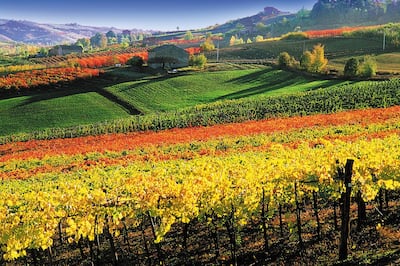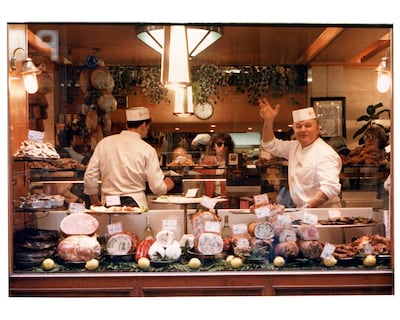Of all the meals I have ever had in a bookshop, the finest would have to be a quintessentially Bolognese dinner at Va Mo La. The unusual restaurant ticked off the first two of the city's three nicknames: Bologna is sometimes referred to as "la dotta, la grassa, la rossa" (the learned, the fat, the red), because it is home to the oldest university in Europe, it has a reputation for good food – even among Italians – and the city has a history of left-wing politics. In Va Mo La, the relaxed atmosphere, soft jazz and lighting, and friendly service were made that much more inviting by the bookshelves that line the walls.
But the food was the main point – and it was sensational. Bologna is famous across the world for its meaty pastas, including tagliatelle alla ragu, lasagne alla Bolognese and tortellini, but it was a fourth kind, seemingly little-known outside the city, or certainly beyond Italy, that won the day. Balanzoni is a folded green pasta made using spinach, like extra-large tortellini, which is filled with pink mortadella and covered in white cheese sauce and crumbled pistachio. It was rich to the point of Medici-like opulence, and yet beguilingly simple and startlingly cheap. The dish was so good that, even with stiff competition in a city full of great pasta and pizza, I could not resist going back for a second time.
The best thing about eating such hearty, heavy food in a beautiful and historic city is that you have no choice but to really commit to walking it off, if you want to have anything approaching an appetite again by dinner time, which, naturally, you do. Fortunately, Bologna is a delightful city to walk around. Even in the heat of summer, you are afforded shade almost everywhere you go, thanks to its porticoed pavements.
Bologna's porticoes are unique in their scope. There are about 40 kilometres of them across the city and they have been nominated in their own right as a Unesco World Heritage Site. The building practice began in the Middle Ages, when substantial rural-to-urban migration took place after the university was established. While other Italian cities banned porticoes, claiming they cluttered up the streets, authorities in Bologna made them a compulsory feature – regulated, so as to be tall enough to allow a man on a horse to pass underneath. With cool stone, marble and mosaic floors, grand pillars and occasional frescoes and bas-relief sculptures dotted high up in the corners, even a stroll to the supermarket feels like an aesthetic treat, and an experience of the city's history. There is something undeniably romantic about strolling underneath them.
There is one specific portico-related feat that makes for a fun, if potentially physically challenging, half-day trip. Bologna has the longest single porticoed footpath in the world, stretching almost 4km from just outside the city centre, all the way through the suburbs and up a fairly substantial hill to the Sanctuary of the Madonna di San Luca. The route takes about an hour to complete on foot, but it's not so much the time or the distance as the gradient that will get the lactic acid building up in your thighs. Bring water – lots of it – or you can take a taxi, or even a funny little train that leaves from the city's central, majestic square, Piazza Maggiore.
However you get there, the point is to get to the top and a vantage point from which you are presented with spectacular views of the city's pinkish-red roof tiles and medieval towers, the dome of the Basilica of San Petronio (the city's huge, unfinished central church), and the green hills beyond. Building regulations have loosened somewhat in recent decades to allow for more modern high-rise buildings, but few are visible from this point and to all intents and purposes, it feels like you are gazing upon an unchanged medieval city full of studious monks and bumpy cobblestones.
Compared to Florence and Venice – which are only an hour and two hours away on the train, respectively – it is also beguilingly calm to wander around Bologna, with the city unspoilt by excessive tourism. There are no battalions of short-stay tour buses overwhelming the main avenues and piazzas here.
And yet this is certainly a city primed to receive visitors, perhaps a legacy of those 12th-century scholars who flooded into its porticoed streets. Despite its cosy atmosphere and walkable centre, Bologna is not small and the city offers a good variety of places to stay. I began in the Al Cappello Rosso Hotel, an amusingly eccentric-looking four-star hotel off Piazza Maggiore, where every room has been designed by an artist with a highly specific theme. Mine was John F Kennedy and the American presidency, and featured a famous speech from JFK plastered over one wall, the US presidential seal printed on a wardrobe, JFK posters and portraits, a model of the late president's boat, and so on. It was all highly entertaining, if slightly disorientating, as I got to grips with an epicentre of Italian culture. About 20 minutes away, across town, I spent my remaining nights at the Una Hotel Bologna Central, a slick and modern business-friendly hotel by the train station, decorated in oranges and reds, which is perfect for travelling to the airport, or taking day trips to Florence or Venice.
One new tourist-focused presence on the outskirts of Bologna has caused both excitement and debate, especially among the city's gastronomic community. Opened with great fanfare at the tail end of 2017, Fico Eataly World claims to be the world's largest food theme park. It is a gargantuan, sprawling miniature town, comprising countless specialist food shops, cafes, restaurants, display kitchens, infographics, games and cookery classes, while outdoors there are allotments, greenhouses and animals. The idea is to showcase Italy's famous regional specialities, from balsamic vinegar from nearby Modena, to another local speciality, the hard and nutty Parmigiano-Reggiano cheese.
Fico Eataly World is so big that special tricycles (with capacious baskets for all your purchases) can be borrowed at the entrance to help visitors get around. What is surreal about the experience is that the theme park's backers say six million visitors a year are expected, which – according to some quick maths – would work out at about 16,000 people per day. During my time there, I saw at most a couple of hundred visitors in two or three hours, many of whom were groups of school children. It was eerily quiet.
Perhaps it will take longer to establish itself, but there has already been tension in Bologna between this culinary mega-mall and some of the independent artisan shops and markets in the city. "It goes against the whole spirit of Italian food," one local resident told us. To them, the national cuisine is all about local delicatessens, or long-established, small-time restaurateurs.
Whatever your view on that subject, as a visitor to Bologna, you can't fail to eat well. Indoor markets within the city proper, such as the Mercato delle Erbe, sell a delightful range of cheeses, jars of truffles and pestos, among other treats, as well as a vibrant display of fruit and veg, and tasty takeaway snacks such as the local piadina flatbread sandwich, should a picnic in one of the city parks take your fancy. Just make sure you allow time to walk it off before dinner.



